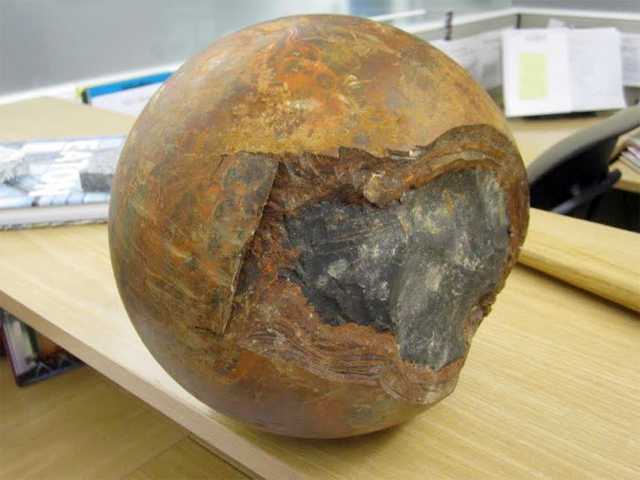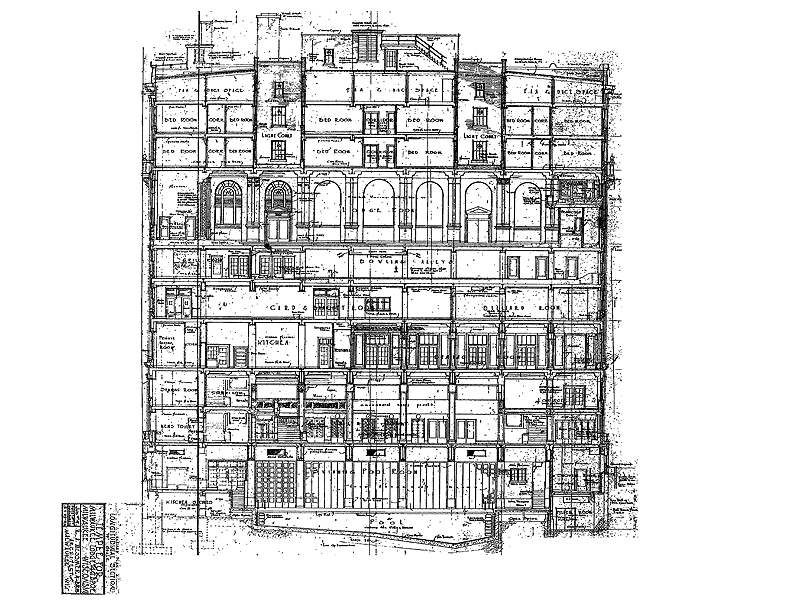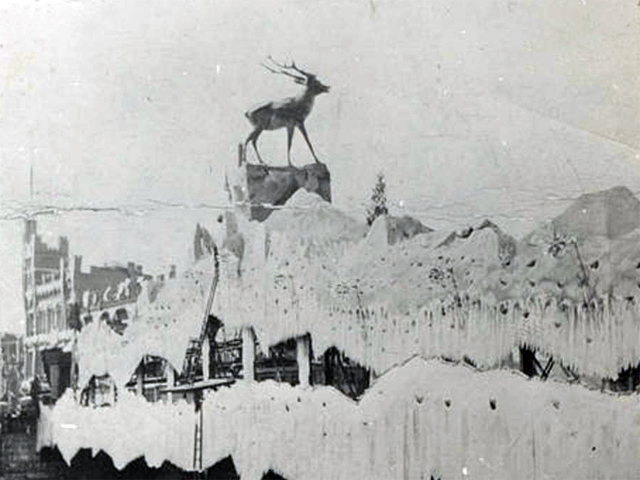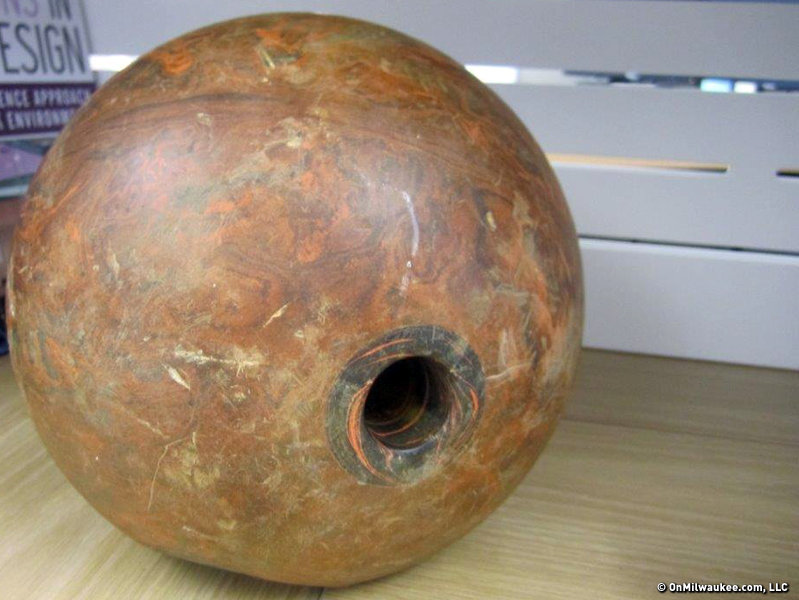History is layered beneath the ground we walk on every day. You don’t need to be an archeologist to know that. But, once in a while, it’s good to be reminded that we walk in the footsteps of others.
And this isn’t only the case in places like Rome, where building most anything quickly gets stymied by the unexpected appearance of ruins. Even in Milwaukee, those who dig, find.
A recent find on the site of the construction of a new tower for Northwestern Mutual can serve as the latest reminder.
A few months ago – the details aren’t exactly clear – workers excavating the site found a fairly large, weighty, round object amid the dirt and rubble. Wiping it off, they realized they’d found a bowling ball (how THAT for Milwaukee?!).
The ball has a marbled appearance swirling with earthy rust and other tones that would probably look stunning with a little polishing (though I’m not suggesting tinkering with artifacts).
Because I saw only one hole, I consulted my bowling guru, Mike Jakubowski – a play-by-play announcer for the Professional Bowlers Association Tour telecasts on ESPN who has held a number of positions with the PBA and United States Bowling Congress – who confirmed that based on the photo, this appears to be a lignum vitae bowling ball.
"The first balls had just a thumb hole and one finger hole. You bowled with two fingers," he said, explaining why one doesn't see the traditional three-hole configuration here. You can see the second hole in this photo of the broken backside of the ball.

It may seem an odd find until one recalls that the 9-story home of the Elks Lodge #46 once occupied a portion of the site – and, in fact, the portion of the site where the lodge was located. The building, built in 1925, was razed in 1971 and on its fourth floor, guests would find the bowling alleys.
The 10 lanes are clearly marked on a longitudinal drawing made by the Robert A. Messmer’s architectural firm in advance of the construction of the 1925 building.

But it sounds like they got a fair bit of use by members and kegeling clubs like the Olympic Bowling Club, which was also known to engage in a bit of card playing at the lodge’s Downtown "temple."
The Milwaukee Elks chapter was established in 1886 and was the 46th in the country. In 1906, the club moved into the old Phoenix Club building at 768 N. Jefferson St. According to an article in the Milwaukee Jewish Historical Society newsletter, the Phoenix Club, "touted itself as a social club for ‘the elite of Jewish society.’"
The 1920s were a boom decade for clubs in Milwaukee and no fewer than seven large clubhouse buildings were put up at that time, including the Excelsior Masonic Lodge in 1921, the Eagles Club in 1925-27, the Tripoli Shrine in 1926-28, the University Club in 1926, the Pythian Castle Lodge in 1927, Jefferson Hall in 1928, and, of course, the Elks Lodge built their new place in 1925.
Some, like the Eagles, Tripoli, University and Jefferson Hall survive. Others, like the Elks’ grand place at the foot of Wisconsin Avenue did not. The stately building must have offered impressive views not only of the lake, but also of Downtown Milwaukee.
The Elks’ Milwaukee "Wonder Lodge" was reportedly the largest Elks clubhouse in the country at the time and the Brew City club boasted a membership around 5,500, including many Jews, which is, sadly, a notable fact.
The building was top-loaded with amenities. In addition to the bowling alleys, there was an Olympic-size pool in the basement (Johnny Weismuller reportedly set a record there in 1935), as well as a sauna, steam room and gym, and tennis and handball courts, along with sunbathing, on the roof.
In between, guests could avail themselves of two floors of guest rooms, a billiards room, a giant sixth-floor lodge hall that could accommodate 600 diners and boasted a Wurlitzer pipe organ, and the Harbor Room restaurant on the fourth floor.
Outside, there was a Stag statue, with two water taps, from which Milwaukeeans collected water. One drew water from a spring in the basement of the lodge and the other served up city water. The taps were capped during World War II.
The statue, a replica of one in Reading, Penn., was presented to the city in 1901 by the Elks and originally stood in Juneau Park, along with a fountain. The statue rode a float down Wisconsin Avenue that year in the Elks Convention parade.
 (Photo: Milwaukee Public Library)
(Photo: Milwaukee Public Library)
When the temple opened in 1927, the Elk was moved there and rested upon a pedestal designed by architect Rubens F. Clas, who was a club member.
That article in the Milwaukee Jewish Historical Society newsletter noted that some Milwaukeeans, "fondly remember being taken to the Elks Club by their father and grandfather, respectively, to swim, ‘schvitz’ and have lunch. ... Friday night was unofficially ‘Jewish night’ at the restaurant when many Jewish members dined and danced to the orchestra that played there. The Elks Club of this time period had more of a professional business/social atmosphere than the Elks Clubs of today."
Those were the days when mayors and prominent attorneys and businessmen could be seen roaming the corridors. But times were changing and by the end of the 1960s, membership was on the decline and the building was showing its age.
So, the Elks moved to a new home out on 55th and Good Hope – they took the cast zinc Elk statue with them – and the land Downtown was sold to NM.
The Wonder Lodge was razed and a few years later the company erected a new office building, which was torn down last year to make room for a larger one that is due to be completed in 2017. There is no plan to include bowling alleys.
Born in Brooklyn, N.Y., where he lived until he was 17, Bobby received his BA-Mass Communications from UWM in 1989 and has lived in Walker's Point, Bay View, Enderis Park, South Milwaukee and on the East Side.
He has published three non-fiction books in Italy – including one about an event in Milwaukee history, which was published in the U.S. in autumn 2010. Four more books, all about Milwaukee, have been published by The History Press.
With his most recent band, The Yell Leaders, Bobby released four LPs and had a songs featured in episodes of TV's "Party of Five" and "Dawson's Creek," and films in Japan, South America and the U.S. The Yell Leaders were named the best unsigned band in their region by VH-1 as part of its Rock Across America 1998 Tour. Most recently, the band contributed tracks to a UK vinyl/CD tribute to the Redskins and collaborated on a track with Italian novelist Enrico Remmert.
He's produced three installments of the "OMCD" series of local music compilations for OnMilwaukee.com and in 2007 produced a CD of Italian music and poetry.
In 2005, he was awarded the City of Asti's (Italy) Journalism Prize for his work focusing on that area. He has also won awards from the Milwaukee Press Club.
He has be heard on 88Nine Radio Milwaukee talking about his "Urban Spelunking" series of stories, in that station's most popular podcast.







